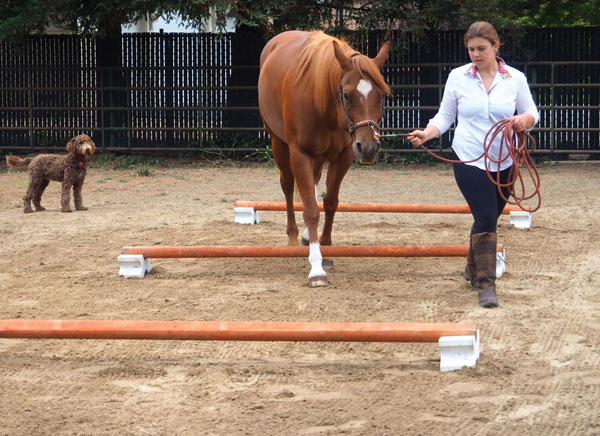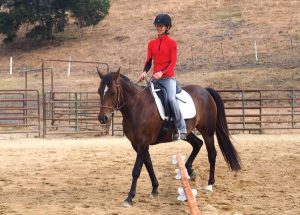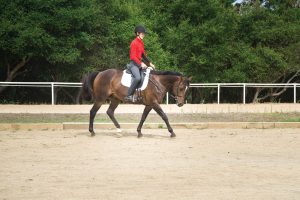
Simple ground pole exercises for horses can sometimes be the most effective because riders are likely to practice them more consistently. And when it comes to movement and fitness, consistency matters above all.
Riders are occasionally surprised how a little rearranging of the horse’s posture, as required with ground pole maneuvers, can create notable improvements. These adjustments include activating and lifting the base of the neck, greater rotation in the trunk and back, and stimulation of sensory nerves in feet and forelegs.
These exercises alone will not make a horse fit, but when practiced for five or 10 minutes before your ride, they help activate nerve pathways and deep postural muscles that might otherwise hibernate during periods of less overall exercise. Practiced with intention and focus, they can function like the type of drills performed by a dancer or sprinter prior to performing a routine.
These exercises can be performed from the saddle, although I generally encourage riders to do them from the ground so they develop a daily habit of observing their horse’s posture and alignment. Making them part of your pre-ride groundwork is a useful part of your warm-up.
For set-up, you can use fence posts, jump poles, or whatever pole you have available that measures at least 2 meters (6 feet) long. By no means do you need to set these up in an arena. Since you only need a small amount of space, I encourage you to use an area outside your arena.
Back and Forth with Forelegs
For horses with a strong side dominance or ones that are tight and restricted on the forehand, I have found this exercise to be helpful.

Most horses will initially step on the pole or be clumsy with their feet. Don’t assume they are being naughty or evasive; continue with the exercise, and generally within several repetitions, the footwork will resolve.
◆ Stand your horse perpendicular to a single pole lying flat on the ground.
◆ Ask him to step one front foot, and then the other, over the pole.
◆ Once both front feet are over, ask him to stand still for 1-2 seconds.
◆ Now ask him to step his feet back across the pole.
◆ And then immediately walk his front feet forward over the pole again.
◆ Continue repeating this forward-backward movement for 6-8 repetitions.
Cross-Over at Oblique Angle
Excellent for stimulating the deep scapular (shoulder) muscles, this maneuver asks the horse to move his foreleg away from his midline, which helps mitigate the effects of repetitive front-to-back movement. If you have small riser blocks available, raise the ends of your pole 6 inches off the ground.
◆ Walk your horse across the pole at a diagonal angle; imagine his body making a 45-degree angle with the pole.
◆ Continue walking back and forth across the pole obliquely …
◆ … OR turn your pattern into a figure-8 by circling around the end of the pole after each time across.
◆ Repeat a dozen times.
Transitions Beside a Pole
In this exercise, the pole serves as an alignment tool. The horse is aware both visually and physically of the pole’s position, and he therefore makes small adjustments to account for his own positioning beside it. In this way, his sensory nerves are stimulated with very little interference on your part.

Remember that sensory nerves communicate with motor nerves. The more we support this communication, the more refined a horse’s movement can become.
The goal is to be as close to the pole as possible at all times without actually standing on it.
◆ Walk your horse energetically toward the pole, aligning him parallel to it.
◆ When the horse’s body is alongside the pole, halt promptly.
◆ Stand immobile for 3 seconds.
◆ Then back up 6 steps, remaining as close to the pole as possible without hitting it.
◆ Immediately walk forward and halt again.
◆ Walk forward away from the pole and prepare to re-approach it, repeating the above sequence.
Once you have repeated the sequence above, you can modify it to include trotting on your approach to the pole. You can also vary which side of the pole you choose to halt in order to keep your horse’s attention.
Transitions Before & After a Pole
The objective here is to make lots of small adjustments to your horse’s balance and energy. I often think of this being akin to a “quick feet” drill that soccer players do.
◆ Place a single pole on the ground or raised to a height of 6 inches.
◆ Walk or jog toward the pole. Two steps before you cross the pole, transition to a different gait/speed to cross the pole. For instance, if you are approaching at a jog, quickly transition down to a walk, step over the pole, and then immediately resume jogging.
◆ Repeat this sequence, alternating transitions between walk, jog, and halt, both before and after you ride across the pole each time.
◆ Be sure you do not repeat the same sequence. The goal is to keep you and your horse alert and responsive.
These are some of my favorite quick, efficient uses of a single pole to keep your horse’s routine engaged when you might have less time or agreeable weather. There are plenty of other creative uses for a single pole, as well: circling around a pole, sidepassing over a pole, straddling a pole with each set of legs, and doing small gymnastic jumps.
The key point is that while a grid or sequence of poles offers terrific strength training, you can still accomplish some good work with one plain old pole on the ground.
This article about ground pole exercises for horses appeared in the March 2021 issue of Horse Illustrated magazine. Click here to subscribe!





